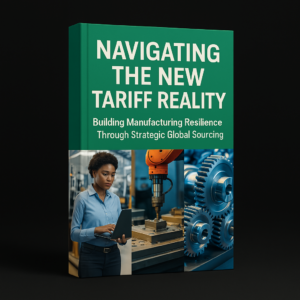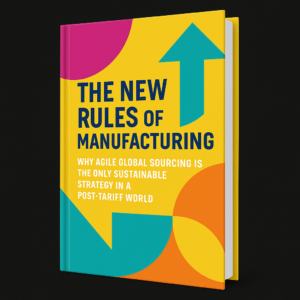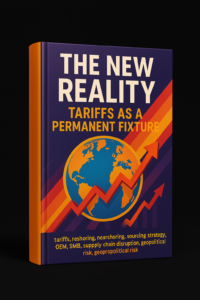
Long lead times and unpredictable deliveries have become a top concern for manufacturers in 2025. As many firms attempt to reshore production due to tariff concerns (see the offered report from my last e-mail on the strategic error of blanket on-shoring) and geopolitical pressures, domestic suppliers are stretched thin. The result? Production capacity bottlenecks, with wait times for certain components doubling or tripling. This report examines the causes of the growing lead time crunch and presents strategies – including global sourcing diversification – that can significantly shorten lead times and build resilience into supply chains.
The Domestic Capacity Squeeze:
The push to manufacture more in America has collided with a hard reality: limited domestic manufacturing capacity. Building new factories and ramping up workforce skills takes years. In the short term, a surge in demand on U.S. contract manufacturers has led to backlogs. Industry observers note that lead times have become wildly unpredictable and often “unbearably long” for many products. Some contributing factors:
- Rapid Demand Shift: The April 2025 tariffs and reshoring momentum prompted companies to abruptly redirect orders from overseas to U.S. suppliers. Many domestic shops are now quoting far longer lead times – sometimes 2–3× their usual – simply because they are over capacity. For instance, a CNC machine shop that once turned parts around in 4 weeks might now quote 10+ weeks due to the influx of new orders.
- Labor and Skills Shortage: U.S. manufacturing was already facing a skilled labor shortage. As demand spikes, the lack of experienced labor further limits how quickly production can scale. According to Deloitte, nearly 60% of U.S. manufacturers cited inability to hire enough skilled workers as a top challenge in late 2024. Fewer workers on the shop floor means existing staff are overloaded. Production queues lengthen and quality takes a hit.
- Supply Chain Ripple Effects: Domestic suppliers often rely on their own supply chains for materials and parts. When everyone is expediting orders, upstream delays (in raw materials, for example) compound the problem. A delay in one link (say, a forge shop waiting on steel stock) cascades to further delays for finished components. Recent data showed that while some supply chain pressures have eased, delivery times for raw materials were still 81 days on average in late 2024, longer than pre-pandemic norms. This indicates lingering sluggishness in supply lines feeding production.
Offshore Capacity: An Underutilized Relief Valve:
Interestingly, while U.S. manufacturing is straining with increasing demand on limited capacity, offshore capacity is growing and can relieve these bottlenecks consistently, with long-term predictable stability. As some companies pivot to domestic sourcing, overseas factories – particularly in Vietnam and the rest of Southeast Asia – are seeing pockets of freed-up capacity. Many of these facilities are ultra-modern and operate 24/7, meaning they can scale up output on short notice. Leveraging this capacity through selective,, professionally managed offshore sourcing or nearshoring can dramatically cut lead times:
- Case in Point: A mid-sized machinery manufacturer in the U.S., faced a critical backlog on a custom electronics housing. Domestic suppliers quoted 12–16 weeks. By engaging a vetted contract manufacturer in Vietnam (with available production slots), they able to get first articles in 4 weeks and production quantities in 6–8 weeks – effectively halving the wait. The offshore partner had invested in advanced CNC lines and was actively seeking new orders (as some Western customers had pulled back due to tariffs). The company’s choice to dual-source globally turned, what would have been a 3-4 month delay, into a manageable, and predictable, 1.5 month timeline.
- Global Multi-Sourcing: Companies are increasingly adopting a multi-source strategy for critical components: one domestic supplier and one offshore supplier. This not only provides backup if one source hits capacity, but also encourages faster delivery through competition. If the domestic lead time slips, the offshore source can pick up the slack (and vice versa). In practice, this has kept production schedules on track. A survey by Thomas in 2024 noted a rise in manufacturers securing alternate suppliers in different regions as a way to improve lead time reliability – essentially, not “putting all eggs in one basket geographically.”
Strategies to Shorten Lead Times Now:
- Audit Your Current Lead Times: Identify which components or materials have the longest lead times or most late deliveries. These are the candidates for intervention. Often, a Pareto analysis shows a handful of items causing most delays.
- Leverage Offshoring for Bottleneck Items: For those long-lead components, investigate capable suppliers in regions with available capacity. Countries like Mexico, Vietnam, India, and Malaysia are gaining production work as alternatives to China and often have capacity buffers. Engaging an offshore partner could cut lead times by 30–50% based on numerous case studies we’ve observed.
- Use Air Freight Strategically: If you do offshore, today’s relatively stable freight costs and improved logistics mean you can expedite initial batches via air without eroding too much margin. This hybrid approach – start with a quick air shipment to gain time, then follow with ocean freight – can jump-start your supply while still capturing cost savings on the bulk shipment.
- Local Buffer Stock: Where possible, build a small buffer inventory of critical parts (especially those coming from overseas) to smooth out transit variability. With uncertainty in shipping (e.g., occasional geopolitical disruptions causing reroutings), a few weeks of safety stock can ensure your production isn’t starved if a shipment is late. The goal is to decouple your production schedule from unpredictable supply hiccups.
- Collaborate and Forecast: Communicate your forecasts and growth plans with both domestic and offshore suppliers. Giving suppliers longer visibility of your demand allows them to plan capacity or add shifts proactively. Suppliers, whether local or abroad, prioritize customers who help them forecast. In a constrained environment, a strong partnership can mean your orders get queued ahead of less communicative customers.
Conclusion:
In a time when “lead time is the new currency” for manufacturers, those who adapt their sourcing strategy will thrive. Combining domestic and offshore sourcing is proving to be a winning formula for lead time reduction. By tapping into global capacity, companies can dramatically improve on-time delivery rates and reduce the risk of stockouts or stalled production. Rather than being at the mercy of an overloaded local supplier base, manufacturers gain options and agility. As a result, they can keep customer commitments, maintain more stable production schedules, and reduce the costly consequences of delays (expedited shipping, line downtime, customer penalties, etc.). In 2025’s capacity crunch, lead time leadership belongs to firms with diversified, resilient supply chains.
Making it Safe, Flexible and Successful:
REDUxEngineering can be your “Managed Offshore Sourcing” department, providing SMB manufacturers the on-demand specialized expertise, pre-vetted CM partners. multiple international destinations, language skills, long-term regional relationships and on-site QA staff needed to safely, efficiently, and quickly tap into the savings that diversified global sourcing has delivered to multi-nationals for decades. Hop on our calendar for a 20 minute briefing: https://app.apollo.io/#/meet/david_orton_b36 , or email us with times that work for you: [email protected].
Sources:
- REDUx Engineering – “The Numbers Don’t Lie” White Paper (2025), on capacity strains.
- Deloitte – 2025 Manufacturing Industry Outlook (Dec 2024), on labor shortages and delivery times.
- Thomas Industrial Survey (2024) – data on dual-sourcing trends (multi-region suppliers).
- U.S. Census Bureau – Trade Data (2024), Mexico #1 trade partner status.
- Reuters – report on Red Sea route delays due to conflict (late 2024).
- REDUx Engineering – Client Case Study (2025), industrial component lead time reduction example.






